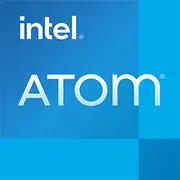Intel Atom Z670

Intel Atom Z670: An Ultra-Budget Processor for Niche Tasks in 2025
An overview of the capabilities and limitations of the Lincroft platform in modern realities
Architecture and Fabrication Process: 45 nm and Minimalism
The Intel Atom Z670 processor, released in 2011, became part of a lineup aimed at ultra-mobile devices. Its architecture (codename Lincroft) is based on the outdated 45 nm fabrication process, which appears archaic in 2025 even when compared to budget solutions.
- Cores and Threads: One core and one thread is the main limitation. In an era of ubiquitous multitasking, even basic processors have 2-4 cores (for example, Intel Celeron N4500). The Atom Z670 runs at a frequency of 1.5 GHz without Turbo Boost support.
- Integrated Graphics: The GPU (PowerVR SGX535) was part of the chipset (Intel SM35), not the processor. Its capabilities were sufficient for decoding 720p video, but nothing more. Modern codecs (AV1, VP9) are not supported.
Power Consumption and TDP: 3 W — A Record or a Shortcoming?
The 3 W TDP is a key feature of the Atom Z670. This allowed for the development of devices without active cooling, but at the cost of performance.
- Thermal Design Power: In comparison, modern Intel Alder Lake-N processors (e.g., N100) with a 6 W TDP offer 4 cores and 4K support.
- Energy Efficiency: Technologies like Intel SpeedStep reduced frequency during idle periods, but the lack of modern methods (e.g., adaptive voltage) made power management primitive.
Performance: Real Tasks in 2025
The Atom Z670 was designed for Windows 7 and Android (in hybrid devices), but in 2025 its capabilities seem questionable.
- Office Tasks: Basic operations in LibreOffice or the web version of Google Docs are possible but laggy. Opening 10 tabs in Chrome (even in Lite mode) will cause slowdowns.
- Multimedia: YouTube at 720p works with stutters without hardware acceleration. Local playback of MP4/H.264 files is acceptable, but 4K or H.265 is not.
- Gaming: Only retro games (e.g., Half-Life 1) or browser projects like "Space Rangers" are viable. Even Minecraft (Java Edition) on minimal settings barely reaches 15 FPS.
Use Cases: Who Needs Atom Z670 in 2025?
This processor is a relic but can still be useful in niche instances:
1. Specialized Devices: Data collection terminals, simple kiosks.
2. Backup Gadgets: An inexpensive laptop for travel where battery life is important, rather than power.
3. Educational Projects: Devices for children, where limited performance is a plus (minimizing distractions).
It is not suitable for use with modern OSes (Windows 11, Linux with heavy DEs).
Battery Life: Long Battery Life
Devices featuring the Atom Z670 (e.g., ASUS Eee Pad Slider) could run for 8-10 hours. In 2025, alternatives with new chips (MediaTek Kompanio 500) offer 5 times more performance with similar battery life.
- Power-Saving Technologies: The lack of "deep sleep" (Modern Standby) and fast wake-up are downsides.
- Tips: For maximum battery life, turn off Wi-Fi and use lightweight OSes (Lubuntu, DietPi).
Comparison with Competitors: Against AMD, Apple, and Modern Atom
- AMD C-60 (2011): Comparable in TDP (3.5 W) but has 2 cores and Radeon HD 6290, handling multitasking better.
- Intel Alder Lake-N (2023): The N100 (6 W, 4 cores) is 5-7 times faster in PassMark tests.
- Apple M1 (2020): A world of difference: the M1 at 10 W TDP outperforms the Atom Z670 by 50 times.
Even modern budget processors (Qualcomm Snapdragon 7c) gain an edge through AI accelerators and 5G support.
Pros and Cons: Why the Atom Z670 Is No Longer Relevant
Strengths:
- Ultra-low power consumption.
- Affordability of devices (new gadgets range from $200-$300).
- Compactness (suitable for palm-sized mini-PCs).
Weaknesses:
- Incompatibility with modern software (e.g., Windows 11 requirements for TPM 2.0).
- Lack of support for USB 3.0, NVMe, Wi-Fi 6.
- Limited upgrade options: RAM and SSD are often soldered to the board.
Laptop Selection Recommendations: Atom Z670 vs. Modernity
If you are considering a device with the Atom Z670 in 2025, ask yourself these questions:
1. Purpose: For email and text work — possibly. For Zoom or Figma — no.
2. Alternatives:
- Budget Chromebooks (e.g., Lenovo Chromebook Duet 3, $299) on Snapdragon 7c: with 12 hours of battery life, supporting Android applications.
- Mini-PCs on Intel N100 (Beelink U59, $180): 4K, 8 GB RAM, SSD.
3. Specifications: 4 GB RAM is essential, SSD (even 64 GB), and a screen resolution of at least 1366x768.
Final Conclusion: Who Is the Atom Z670 For?
This processor is a choice for a very limited range of tasks:
- Retro Tech Enthusiasts: Building minimalist devices.
- Corporate Sector: Where cheap terminals with long battery life are needed.
- Backup Devices: “Just in case” for trips.
Key Benefits: Price (new devices start at $200), silence, compatibility with outdated systems. However, for most users in 2025, it makes more sense to choose modern alternatives even in the low-price segment.
Note: Prices are current as of April 2025. Devices featuring the Atom Z670 are rarely produced; the bulk of the market consists of refurbished models or niche OEM solutions.
Basic
CPU Specifications
Memory Specifications
GPU Specifications
Benchmarks
Compared to Other CPU
Share in social media
Or Link To Us
<a href="https://cputronic.com/en/cpu/intel-atom-z670" target="_blank">Intel Atom Z670</a>